|
|
October 14th, 2011
Graham Bull has again seen a Eurasian Oystercatcher at Langebaan Lagoon, West Coast National Park. The bird apparently spends most of its time north of Seeberg hide. I wonder if this is the same bird that Graham reported in January this year?
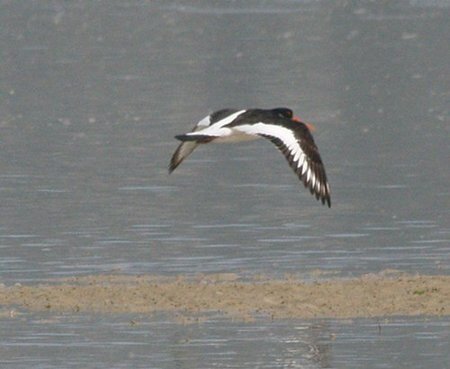
Thanks Graham.
David Winter
June 24th, 2011
Mike Buckham and I were keen to track down some Chestnut-banded Plovers on the West Coast earlier this year. We weren’t interested in “speck on the horizon” type views, we wanted them close. Mike, via CapeBirdNet, managed to make contact with the owners of the farm and guest house, Kuifkopvisvanger, which is located on the southern shores of the berg river and is reputably a reliable spot for them.
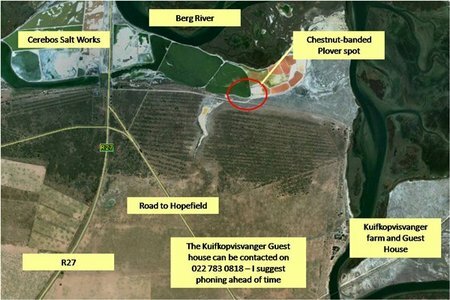
Map adapted from Google Earth
The guest farm can be contacted on 022 783 0818 and I suggest you phone ahead to make arrangements. The spot was easy to find – see map above – and we weren’t disappointed. We found at least 15 individuals and using our car as a hide we were able to get within about 10 metres of them.
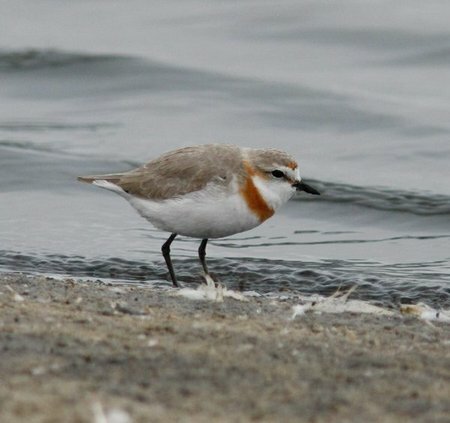
Chestnut-banded Plover (male)

Chestnut-banded Plover (male)
We noted some interesting territorial behaviour while we were snapping these pics. As mentioned, there were at least 15 individual birds, both males and females, and one particular male spent a lot of his time chasing the other males around him. He would flatten his body (perhaps to appear bigger?) and strut around like he owned the place! The shots below were through the wind screen, but you’ll get the idea.
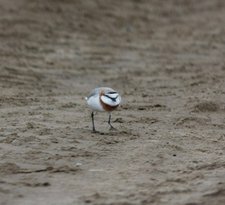 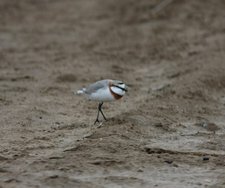 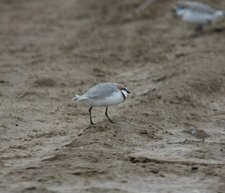
Don’t mess with me…
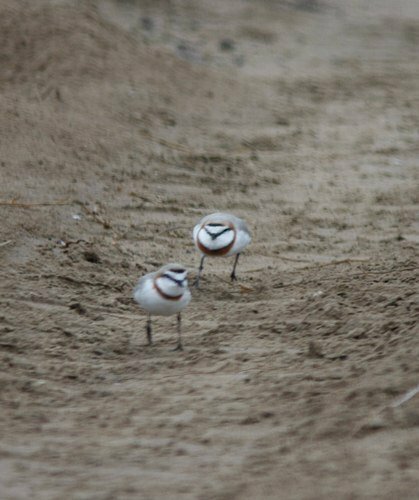
The chase…
David Winter
August 12th, 2010
Guilty of often missing the great spring birding in August each year, I decided to drive the Darling Hills road a few Sundays ago to see if there was any early activity. For those not familiar with the area, the Darling Hills road is a gravel road that runs from the R27 through the wheatlands south of Darling, joining up with the Old Darling road (R307) south-east of the town.

I jumped the gun a bit in terms of my timing. The birding was good and birds were vocal, but it was nothing like a sunny spring day when just about every field has either a Zitting or Cloud Cisticola competing for air space with a displaying African Pipit or Red-capped Lark.

Red-capped Lark
My first stop (at 1 on the map) turned up a pair of Grey-winged Francolin and a vocal, but distant male Southern Black Korhaan. Common Fiscal, Cape Sparrow, Speckled Mousebird, Karoo Scrub-robin, Grey-backed Cisticola and Bokmakierie can be found here as well and this occasion was no different.

Capped Wheatear
Point 2 on the map is a small farm dam where you can find South African Shelduck and Blacksmith Plover around the water’s edge and Capped Wheatear, Red-capped Lark and Pied or Wattled Starling in the surrounding fields. In spring and summer this is also a good spot to check the phone lines for Hirundines as Barn and Greater Striped Swallow, Brown-throated and Banded Martin and occasionally Pearl-breasted Swallow can be seen. A little further along, in the vicinity of the farm buildings, an African Hoopoe was rather uncooperative as it gave me the run-around. Next time…
In a bit of a rush I skipped out the last section, but for those with more time points 3 and 4 are good areas for Karoo and Cape Clapper Lark respectively. Karoo Lark is probably more easily seen in the West Coast National Park, but any stretch of decent-sized strandveld in this area should turn up a Cape Clapper, given that you’re early enough to hear them clapping, of course.
Enjoy and please check with the farmer before venturing onto any land, all of it is private.
Bird List:
Milnerton Lagoon area: Pied Crow, Hartlaub’s Gull, Yellow-billed Duck, Egyptian Goose, Cape Longclaw, Blacksmith Plover, Grey Heron, Hadeda Ibis, Cape Wagtail, Red-knobbed Coot, Little Grebe, Great-crested Grebe, Cape Weaver, Cape Shovellor, Helmeted Guineafowl, Mallard, Cape Francolin, Black-crowned Night-Heron, Common Starling, Kelp Gull, Levaillant’s Cisticola, Lesser Swamp Warbler, Cape Sparrow, Common Moorhen, White-backed Duck, Black Crake, Red-eyed Dove, African Goshawk.
Darling Hills Road: Karoo Prinia, Speckled Mousebird, Southern Black Korhaan, Grey-backed Cisticola, Common Fiscal, Bokmakierie, Black-shouldered Kite, Karoo Scrub-robin, White-backed Mousebird, Pied Starling, African Pipit, South African Shelduck, Red-capped Lark, Crowned Plover, Wattled Starling, African Hoopoe, Southern Double-collared Sunbird, Cape Canary, Cape Turtle Dove, Fiscal Flycatcher, Brimstone Canary, Common Waxbill, Cape Batis, Cape Robin-chat, Malachite Sunbird, Common Titbabbler, Cattle Egret, Cloud Cisticola, Rock Martin, Yellow Bishop, African Stonechat, Cape Bulbul, Cape Clapper Lark, Jackal Buzzard, Rock Kestrel.
David Winter
March 17th, 2010
Don’t forget to also look at some Strandveld birds this weekend if you’re heading to Langebaan for the rarities. I found the entrance road to Seeberg hide to be particularly productive last Sunday. All the usuals were in attendance, but I was especially pleased with two very confiding Cape Penduline Tits at the Seeberg car park. Listen for the distinctive “dee-dee” call, but also their softer “chink” contact call, which one often hears more frequently.

Another luck was the covey of 9 Grey-winged Francolin that decided the road-side dust was the best for bathing. They were completely relaxed with my presence (in a car) and a few individuals had no qualms sorting out some pecking-order politics with me looking on.

Always a highlight is Black Harrier, and there are plenty floating around at the moment. I notched up 4 individuals on Sunday and this “habitat shot” 

Enjoy and good luck to those chasing the rare waders.
David Winter
March 14th, 2010
Even the most hardened wader-buff would have enjoyed Sunday’s flurry of rare shorebirds that Seeberg hide at Langebaan lagoon had to offer. Centre stage was dominated by the Hudsonian Godwit, but a single Broad-billed Sandpiper and two Lesser Sand Plovers also kept people on their toes.

I arrived at Langebaan quite late (8h30) by “rare wader twitching” standards to find the tide very low. Both Geelbek and Seeberg were practically deserted of any shorebirds bar distant, hazy specks on the horizon. Things only really started getting exciting after 12pm when I bumped into John Graham at Seeberg hide. The tide was slowly starting to push and within 5 minutes of setting up his scope John had found a Lesser Sand Plover (he had already seen 2 that morning at Seeberg) and a Broad-billed Sandpiper! My photo below is a strong contender for the world’s worst image of a Broad-billed Sandpiper, but the jizz is distinct enough.

The Hudsonian Godwit wasn’t quite so easy. A lot of time was spent scouring all godwits, particularly in flight, but they all seemed to have tails like the bird below – barred!

Eventually, however, the distinctive black tail, wing bar and dark underwing coverts of the Hudsonian were picked out in flight. Again, the below images are dismal, but you get the idea:


Good luck to those chasing any of these birds. A word of advice, check the tide table before you go and make sure you’re there close to high tide.
David Winter
Bird list for the day: Black Harrier, African Marsh Harrier, Cape Francolin, Black-shouldered Kite, Common Titbabbler, Grey-winged Francolin, Pied Starling, Common Starling, Steppe Buzzard, Black-headed Heron, Southern Double-collared Sunbird, Malachite Sunbird, Cape Sparrow, Bokmakierie, Cape Bulbul, Cape Penduline Tit, Karoo Scrub Robin, Barn Swallow, Pearl-breasted Swallow, Little Swift, Kitlitz’s Plover, White-fronted Plover, Terek Sandpiper, Whimbrel, Broad-billed Sandpiper, Lesser Sand Plover, Grey Plover, Bar-tailed Godwit, Hudsonian Godwit, Curlew Sandpiper, Greenshank, Red Knot, Common Ringed Plover, Little Stint, Ruddy Turnstone, Litte Egret, Swift Tern, Little Tern, Common Tern, Caspian Tern, Sanderling, Blacksmith Plover, Great Flamingo.
December 21st, 2009
Geelbek hide at Langebaan lagoon has been quiet on the rare wader front this summer, bar a Redshank and Mongolian Plover that have been putting in the odd appearance. I was lucky enough to catch-up with the Mongolian a few weeks ago.

Initially the bird was quite distant, but the rising tide eventually pushed it fairly close to the hide. The wing bar and general upperwing colouration in the shot below is a little overdone in Photoshop – it wasn’t that dark.

This image below provides a better idea of the upperwing colouration – this shot has only been cropped.

Apart from the waders, summer is also a time when snakes are more active in the park. I’ve never been lucky enough to see puffadder or any cobras, but molesnakes are fairly common. This individual was just warming up on the road close to the Geelbek hide. The shot only shows a small section of the animal – it was at least a metre long!

December 18th, 2009
Wednesday, a public holiday in South Africa, was spent birding with mates in the West Coast National Park. Located on the southern leg of Langebaan lagoon, the park is without equal in South Africa when it comes to the number and variety of shorebirds one can see. The Strandveld (local vegetation type) birding is also very good.
 There are three excellent hides located on the eastern shores of the lagoon. The older hide (northern hide) at Geelbek is, in my opinion, the best, while Seeberg hide comes into its own at high tide when gulls, terns and shorebirds roost on the sand banks. You need to time the tides quite carefully; the optimal time is either a rising low tide or dropping high tide in the morning (the sun will be at your back). High tide at either of the Geelbek hides is hopeless because there is no exposed mud; Seeberg is less dependent on tides. There are three excellent hides located on the eastern shores of the lagoon. The older hide (northern hide) at Geelbek is, in my opinion, the best, while Seeberg hide comes into its own at high tide when gulls, terns and shorebirds roost on the sand banks. You need to time the tides quite carefully; the optimal time is either a rising low tide or dropping high tide in the morning (the sun will be at your back). High tide at either of the Geelbek hides is hopeless because there is no exposed mud; Seeberg is less dependent on tides.
 The northern Geelbek hide produced: Greenshank, Marsh Sandpiper, Little Stint, Curlew Sandpiper, Eurasian Curlew, Whimbrel, Ruddy Turnstone, Terek Sandpiper, Sanderling, Bar-tailed Godwit and Grey, Ringed, White-fronted and Kitlitz’s Plovers. The northern Geelbek hide produced: Greenshank, Marsh Sandpiper, Little Stint, Curlew Sandpiper, Eurasian Curlew, Whimbrel, Ruddy Turnstone, Terek Sandpiper, Sanderling, Bar-tailed Godwit and Grey, Ringed, White-fronted and Kitlitz’s Plovers.


Interestingly, we spotted this partially leucistic Curlew Sandpiper. The photo is rather poor, but you get the general idea.

We only spent the morning in the park, but managed to notch up about 90 species – we limited ourselves to the southern section because we were atlassing that specific pentad for the South African Bird Atlas Project (SABAP2). Interesting birds for the park included Lesser Honeyguide, Common Swift (uncommon summer visitor) and Spotted Flycatcher (rare summer visitor in the Western Cape). Both the Lesser Honeyguide and Spotted Flycatcher were in the Spider Gums at the northern Geelbek hide.

The Lesser Honeyguide was actively hawking insects, so it wasn’t the best behaved photo subject…

Talking of subject behaviour, swifts in general don’t rank high. We saw a handful of Common Swifts through the morning, usually singletons. The above shot – as with all my other swift shots – was a fluke!

I’ve only seen Spotted Flycatcher once before in the Western Cape at Paarl Sewage Treatment Works (in 1993) so it was good to bag this one after a 16 year hiatus. This time gap is more a reflection of my lack of birding rather than the birds status. Our last stop for the day was the Abrahamskraal water hole, a good drinking spot for birds. Namaqua Doves are still very active in the park – I managed to snap this immature bird.

|
|























 There are three excellent hides located on the eastern shores of the lagoon. The older hide (northern hide) at Geelbek is, in my opinion, the best, while Seeberg hide comes into its own at high tide when gulls, terns and shorebirds roost on the sand banks. You need to time the tides quite carefully; the optimal time is either a rising low tide or dropping high tide in the morning (the sun will be at your back). High tide at either of the Geelbek hides is hopeless because there is no exposed mud; Seeberg is less dependent on tides.
There are three excellent hides located on the eastern shores of the lagoon. The older hide (northern hide) at Geelbek is, in my opinion, the best, while Seeberg hide comes into its own at high tide when gulls, terns and shorebirds roost on the sand banks. You need to time the tides quite carefully; the optimal time is either a rising low tide or dropping high tide in the morning (the sun will be at your back). High tide at either of the Geelbek hides is hopeless because there is no exposed mud; Seeberg is less dependent on tides. The northern Geelbek hide produced: Greenshank, Marsh Sandpiper, Little Stint, Curlew Sandpiper, Eurasian Curlew, Whimbrel, Ruddy Turnstone, Terek Sandpiper, Sanderling, Bar-tailed Godwit and Grey, Ringed, White-fronted and Kitlitz’s Plovers.
The northern Geelbek hide produced: Greenshank, Marsh Sandpiper, Little Stint, Curlew Sandpiper, Eurasian Curlew, Whimbrel, Ruddy Turnstone, Terek Sandpiper, Sanderling, Bar-tailed Godwit and Grey, Ringed, White-fronted and Kitlitz’s Plovers.






Recent Comments